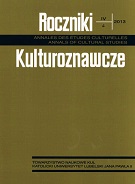Pojęcie "kultura" w trzech katolickich encyklopediach
The Notion of "Culture" in the Three Catholic Encyclopedias
Author(s): Krzysztof LeśniewskiSubject(s): Cultural Essay, Political Essay, Societal Essay
Published by: Towarzystwo Naukowe KUL & Katolicki Uniwersytet Lubelski Jana Pawła II
Keywords: culture; the Catholic encyclopedia; religion; the Roman Catholic Church; society; theological aspect of culture; philosophical aspect of the culture; the social aspect of culture
Summary/Abstract: strona główna O nas Aktualności Działalność naukowa Działalność wydawnicza Sklep Kontakt Home About us News Scientific activities Publications Shop Contact - O Towarzystwie - Władze - Walne Zebranie - Zarząd - Komisja Rewizyjna - Statut - Struktura organizacyjna - Wydziały - Komisje - Członkowie (wg Wydziałów) - Nagroda - Regulamin - Laureaci - Historia Towarzystwa - Galeria - Projekty badawcze - Konferencje/sympozja - Odczyty - Książki - Czasopisma - Encyklopedia Katolicka As today is understood culture from the Roman Catholic point of view? Looking for an answer for this question Author took into consideration three Catholic Encyclopedias, which had been prepared for people living in three different circles of civilization. He compared the scope of the word “culture” in the three Catholic encyclopedias, which appeared in the following languages: Polish, English, and Russian. The first of these works is Encyklopedia Katolicka. It has been prepared by the Institute of Lexicography of the John Paul II Catholic University of Lublin. The second work is New Catholic Encyclopedia, which was created in collaboration of Gale Publishing with Catholic University of America in Washington. And the third piece is Katolicheskaya encyclopedia — prepared and published in Russia. Firstly, in this article presents a structure analysis and comparison of possible ways of determining culture. Then there are shown three aspects of culture: philosophical, theological and social. The last part of the article deals with two different concepts of culture, namely the theory of a cultural growth and the relationship between culture and religion. A comparison and an analysis of the source material taken from the notions “culture” were the basis for the Author to indicate a number of conclusions.
Journal: Roczniki Kulturoznawcze
- Issue Year: 4/2013
- Issue No: 4
- Page Range: 25-46
- Page Count: 22
- Language: Polish

